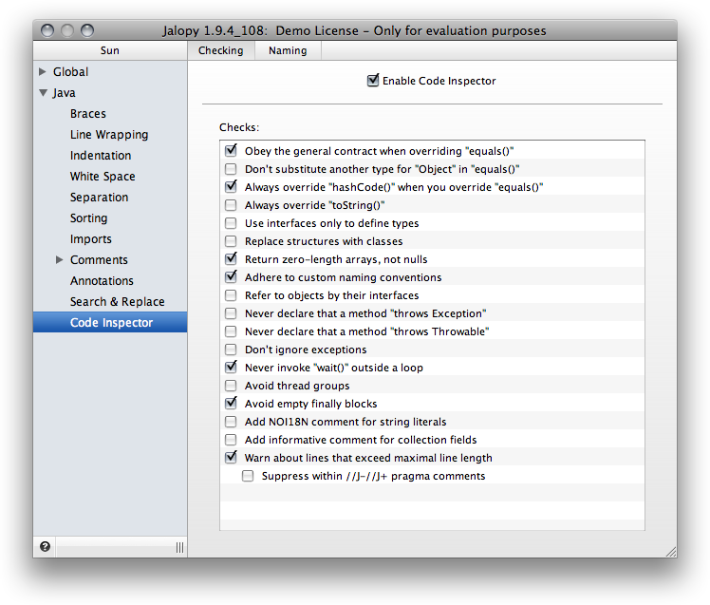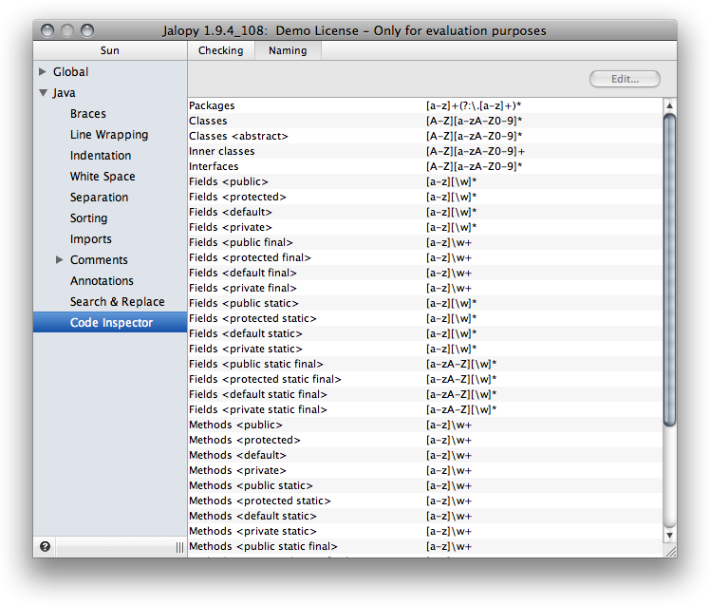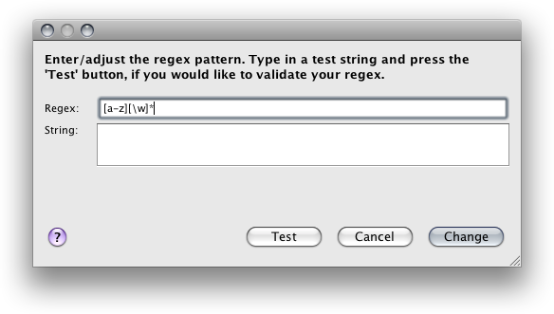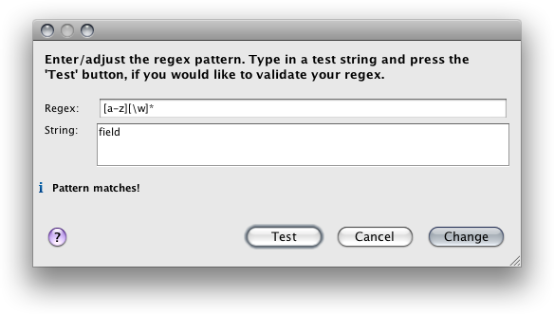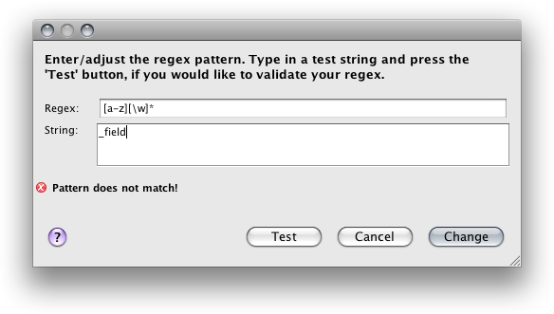Lets you configure the code inspector. The code inspector inspects source files for naming convention violations and possible code weaknesses.
Lets you control the general code inspector settings.
Enable
Lets you enable or disable the code inspector. You still need to enable at least one of the provided checks.
Lets you selectively choose what actions should be performed during inspection.
Obey the general contract when overriding equals
Checks whether the body of a equals method contains a
throw statement that would violate the equals contract. Only
applies if the method body does contain more than one statement; thus, if the
method body consists of a single throw statement, we assume
you know what you do and leave it alone. For more information see
Effective Java [Bloch01], Item 7, pp. 32.
Don’t substitute another type for Object
Don’t substitute another type for Object in the equals
declaration
The equals method should not be overloaded.
For a detailed discussion see Effective Java [Bloch01], Item 7, pp. 35.
Always override hashCode when you override equals
Failure to do so will result in a violation of the general contract for
Object#hashCode, which will prevent the class from
functioning properly in conjunction with all hash-based collections, including
HashMap and HashSet.
For a detailed discussion see Effective Java
[Bloch01], Item 8, pp. 36.
Always override toString
It might be quite useful for diagnostic purposes to have objects generating
interesting information with toString. This way you can
easily use logging techniques to track programs execution.
Example 2.895. Provide useful toString() implemenation
System.out.println("Failed to connect: " + phoneNumber);
For a detailed discussion see Effective Java [Bloch01], Item 9, pp. 42.
Use interfaces only to define types
Interfaces should say something about what a client can do with instances of the class. It is inappropriate to define an interface for any other purpose. When enabled, Jalopy warns about uses of the so-called constant interfaces pattern, i.e. an interface that only consists of constants.
Example 2.896. Constant interface pattern - DO NOT USE!
public interface PysicalConstants { /** Boltzmann constant (J/K) */ double BOLTZMANN_CONSTANT = 1.3806503e-23; /** Mass of the electron (kg) */ double ELECTRON_MASS = 9.10938188e-31; }
For a detailed discussion see Effective Java [Bloch01], Item 89, pp. 89.
Replace structures with classes
Degenerated classes consisting solely of data fields are loosely equivalent to C structures, but should not be used as they do not offer the benefits of encapsulation.
Example 2.897. Public degenerate class - DO NOT USE!
public class Point { public float x; public float y; }
For a detailed discussion see Effective Java [Bloch01], Item 19, pp. 97.
Return zero-length arrays, not nulls
There is really no reason to ever return null from an
array-valued method instead of returning a zero-length array.
For a detailed discussion see Effective Java
[Bloch01], Item 27, pp. 134.
Adhere to custom naming conventions
Following a naming convention aids readability and maintenance as confusion and irritation is avoided. For a detailed discussion see Effective Java [Bloch01], Item 38, pp. 165.
Refer to objects by their interfaces
When possible, always use the interface type for parameters, return values, variables and fields as your program will be much more flexible. When enabled, Jalopy will print warnings when the different Java collection implementations are used directly.
Example 2.899. // Bad - uses interface as type - DO NOT USE!
ArrayList subscribers = new ArrayList();
For a detailed discussion see Effective Java [Bloch01], Item 34, pp. 156.
Never declare that a method “throws Exception”
It is usually bad practise to declare that a method throws
Exception because it obscures any other exception that may
be thrown in the same context and denies any guidance to the programmer
conceding the exceptions that the method is capable of throwing.
For a detailed discussion see Effective Java
[Bloch01], Item 44, pp. 181.
Never declare that a method “throws Throwable”
It is usually bad practise to declare that a method throws
Throwable because it obscures any other exception that may
be thrown in the same context and denies any guidance to the programmer
conceding the exceptions that the method is capable of throwing.
For a detailed discussion see Effective Java
[Bloch01], Item 44, pp. 181.
Don’t ignore exceptions
An empty catch block defeats the purpose of exceptions. At the very least, the catch block should contain a comment explaining why it is appropriate to ignore the exception.
Example 2.900. Empty catch block ignores exception - DO NOT USE!
try { ... } catch (SomeException ex) { }
For a detailed discussion see Effective Java [Bloch01], Item 47, pp. 187.
Never invoke wait outside a loop
Always use the wait loop idiom to invoke the
wait method. Never invoke it outside of a loop as the loop
serves to test the condition before and after waiting ensuring
liveness and safety
For a detailed discussion see Effective Java
[Bloch01], Item 50, pp. 201.
Avoid thread groups
As thread groups are largely obsolete, don’t use them. They don’t provide much in the way of useful functionality, and much of the functionality they do provide is flawed. For a detailed discussion see Effective Java [Bloch01], Item 53, pp. 211.
Avoid empty finally blocks
Empty finally blocks are of no use and may indicate
programmer errors.
Example 2.901. Empty finally block
Writer writer = new BufferedWriter(new FileWriter(file)); try { write.write(data); } catch (IOException ex) { System.err.println("file could not be written: " + file); } finally { }
The programmer certainly wanted to close the Writer in
the finally block to ensure that allocated system resources
will be freed.
Add NOI18N comment for string literals
Enabling this check will cause warnings for all string literals without associated
/* NOI18N */ comment.
Internationalizing Java applications is often done with nifty tools that use
marker comments to indicate that a given string literal should not be considered
for localization. Most tools (at least the ones I know of) use trailing
single-line comments which may not be very robust for processing with a
formatting tool such as Jalopy. In contrast the author uses a multi-line comment
of the form /* NOI18N */ that gets directly placed after a
string literal and will therefore always stuck with it.
Example 2.902. $NON-NLS-1$ comment
FileDialog dialog = new FileDialog(this, ResourceBundle.getBundle(BUNDLE_NAME) .getString("BTN_SAVE_AS", FileDialog.SAVE); //$NON-NLS-1$
This trailing comment could be easily moved away from its string literal during formatting which would result in an unwanted notice on successive internationalization runs.
Example 2.903. $NON-NLS-1$ comment (moved)
FileDialog dialog =
new FileDialog(this,
ResourceBundle.getBundle(BUNDLE_NAME).
getString("BTN_SAVE_AS",
FileDialog.SAVE); //$NON-NLS-1$
Example 2.904. NOI18N comment
FileDialog dialog =
new FileDialog(this,
ResourceBundle.getBundle(BUNDLE_NAME).
getString("BTN_SAVE_AS" /* NOI18N */),
FileDialog.SAVE);
Add informative comment for collection fields
When not using strong-typed collections (a.k.a. Java Generics), it is best to document the object type of the items hold by a collection. When enabled, Jalopy checks for the existence of such comments and warns when they are missing.
Example 2.905. Collection comment
private List _favorableTypes = new ArrayList(20); // List of <String>
Warn about lines that exceed the maximal line length
When enabled, prints a warning for every line that was not printed in between the maximal line length.
Example 2.906. Line length limit
throw new IllegalArgumentException( | "condition must be one of WHEN_IN_FOCUSED_WINDOW or WHEN_FOCUSED"); |
Suppress within //J- //J+ pragma comments
When enabled, no warnings are printed for code sections enclosed with pragma comments.
Since 1.8
Example 2.907. Line length limit
//J- throw new IllegalArgumentException( | "condition must be one of WHEN_IN_FOCUSED_WINDOW or WHEN_FOCUSED"); //J+ |
Lets you specify the naming constraints for different Java source file elements. These constraints are naturally expressed with regular expressions. Note that you have to enable both the Code Inspector and the naming convention check in order to see naming checks performed. See Section 2.8.19.1.1, “Adhere to custom naming conventions” for more information.
The list component displays all provided naming checks along with their current regular expression.
Selecting an item in the list and either pressing the Edit... button or double-clicking the item will open a dialog that lets you change the regular expression.
The Change Naming Pattern dialog lets you interactively craft a valid regular expression for a naming check.
Regex
The Regex text field is where you have to insert the regular expression. This text field initially contains the current pattern for the list item that is under construction.
Jalopy uses Java’s build-in regular expression engine which is roughly equivalent with Perl 5 regular expressions. The syntax is explained here: http://java.sun.com/javase/6/docs/api/java/util/regex/Pattern.html. For a more precise description of the behavior of regular expression constructs consult Mastering Regular Expressions [Friedl97]. The defined pattern must match exactly.
String
The String text field is where you have to enter a string that should be matched by the specified regular expression. This text field is initially empty.
Test
Once you have edited the two text fields you may want to use the Test button to perform a pattern matching test in order to make sure that the specified regex matches as desired. You will be informed about the match status and can decide whether you want to alter your pattern and/or test string and restart the procedure.
Change
If you are finished editing the regular expression, you can press the Change button to take over.
Cancel
You can always use the Cancel button to cancel editing at any time. The dialog will be closed and no changes applied to the list.
